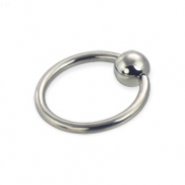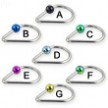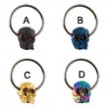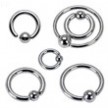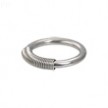Captive bead ring, 14 ga
- Gauge (Thickness): 14 (1.6mm)
- Material: 316L surgical grade stainless steel
- Type: captive bead ring
Shown: 12mm captive ring with 5mm ball.
| Click on the picture to see a big picture and description of the body jewelry you are interested in. | |||||||||
|---|---|---|---|---|---|---|---|---|---|
|
Pear-shaped captive bead ring with anodized...
$4.99
Pear-shaped captive bead ring with anodized ball, 14 ga
|
Captive bead ring with skull, 16...
$7.99
Captive bead ring with skull, 16 ga
|
316L Surgical Steel One Side Fixed...
$3.99
316L Surgical Steel One Side Fixed Ball Ring, 18ga
|
Spring wire captive ring, 12 ga
$6.49
Spring wire captive ring, 12 ga
|
||||||
PLAY PIERCING
Play piercing needles are available, presterilized, through most jewelry and piercing suppliers. These needles are usually of thinner (22-18) gauge, designed the same as piercing needles. Hypodermic needles are often used for play piercing. Needles used in play piercing should only be used once and should be disposed of via medical Sharps container or placed in a sealed container containing chlorox.
The area to be pierced should be disinfected with Betadine or antibacterial soap just prior to piercing. The piercer should wear latex gloves. In an established relationship where contact with body fluids is not a concern, the piercer may wash his/her hands thoroughly with antibacterial soap. After the needle is removed the area should be cleaned with an antiseptic to prevent infection.
Let common sense guide you. If you are unsure of an area of the body and what lies beneath the skin do not pierce!
